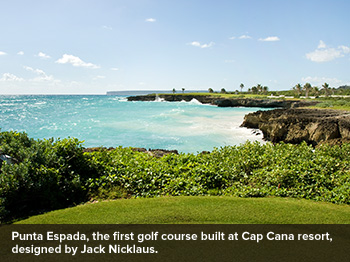Picking an island for the perfect Caribbean vacation can be a daunting task, but picking one for the perfect Caribbean golf vacation is easy. Even golfers who agree on little else (former Presidents Bill Clinton and George H.W. Bush, for example) seem to be in consensus on this; both chose the Dominican Republic.
Head and shoulders above surrounding islands, the D.R. has a golf course for every taste, from time-honored classics to cutting-edge modern interpretations, and a Who's Who of acclaimed designers. Golf here is also exceedingly tourist friendly—just about every top Dominican course is public, open to resort guests and outsiders alike.

THE SOUTH SHORE
A century before visitors flocked to Park City for the snow on the mountains, they came for what was being discovered inside them. Beginning in the late 1860s, miners hammered millions of dollars’ worth of silver out of the surrounding canyons. Mining fueled a bawdy boomtown filled with gambling halls and saloons, much to the horror of Utah’s more conservative surrounding communities.
The Dominican Republic burst onto the international golf scene in 1971, when the legendary Pete Dye built Teeth of the Dog on the southern coast. Named for the jagged shoreline, the course is famous for its 7 waterfront holes where waves crash against tee boxes and golfers are showered in salty mist. Many describe these unforgettable holes as being more in the ocean than on it. Nearly four decades later, this remains the only course in the Caribbean ranked in the World's Top 100 by Golf Magazine.
But Dominican golf goes way beyond Teeth of the Dog. The same resort, the giant Casa de Campo in La Romana, is home to another Dye standout called, appropriately enough, Dye Fore. It lacks the oceanfront drama but sits on high bluffs that overlook the Chavon River, a place so wild it was used to film the Vietnam river journey in Apocalypse Now. With its dramatic views and sharp cliff-edge drop-offs, the course is yin to Teeth of the Dog's yang. The ever-busy Dye has also recently another river-top layout that has expanded the 18-hole Dye Fore course into a 36-hole complex to die for.
PUNTA CANA
The area around Punta Cana, on the easternmost coast, has long been the D.R.'s tourism epicenter. More recently, it has become a hotbed for golf. This started with La Cana, the brainchild of P.B. Dye, Pete Dye's son and an acclaimed designer in his own right. The course is part of the Punta Cana Resort & Club, an upscale residential community whose owners include singer Julio Iglesias and designer Oscar de la Renta. The younger Dye added drama to an already gorgeous oceanfront setting by creating deep pot bunkers, vast waste areas and high grassy mounds, all interspersed with swaying palms and constant sea views.
Nearby is the 30,000-acre Cap Cana resort community, which over the past 10 years has built 5 new golf courses. The first, Punta Espada, was designed by the most legendary name in the game, Jack Nicklaus. When it opened, with ocean views from every hole, Punta Espada received rave reviews; it has already hosted a Champions (Senior PGA) Tour tournament. A second Nicklaus design at Cap Cana, Las Iguanas, is due opened in 2010.
The final big-name addition to Punta Cana is the Faldo Legacy Course at the Westin Roco Ki resort. Designed by 6-time major winner Nick Faldo, it's surprisingly varied, winding through mangrove forests and along 4 lakes before climbing steeply to a stunning finale on rocky cliffs above the ocean. From the back tees, it's also one of the stiffest tests and longest courses in the Caribbean, at 7,152 yards.
THE NORTH SHORE
These days, the highest concentration of excellent golf courses is found in the south and east, but the original D.R. golf destination was the north shore. The late great Robert Trent Jones, Sr. designed 2 courses here. While the options may be limited, prices are considerably lower: This region offers the island's best golf value.
Nearby Playa Grande in Cabrera is a hidden gem, set in a beautiful and otherwise undeveloped 2,000-acre swath of coastal jungle. The course is claimed to be the last designed by Jones, the father of modern golf-course architecture. Whether or not that's true, Playa Grande is a must-play. It could fairly be considered the Pebble Beach of the Caribbean, sitting atop dramatic cliffs at the edge of the sea. There are some differences: Pebble Beach has 9 of these famous cliff-top holes, whereas Playa Grande counts an even dozen. And Playa Grande is one-fifth the price.
THE DETAILS
TEETH OF THE DOG, CASA DE CAMPO* : casadecampo.com.do
DYE FORE, CASA DE CAMPO* : casadecampo.com.do; greens fee
LA CANA, PUNTA CANA RESORT & CLUB: puntacana.com
PUNTA ESPADA, CAP CANA: capcana.com
FALDO LEGACY COURSE, ROCO KI GOLF CLUB: thefaldolegacycourse.com
PLAYA DORADA: playadoradagolf.com
PLAYA GRANDE: playagrande.com
NOTE: Information may have changed since publication. Please confirm key details before planning your trip.